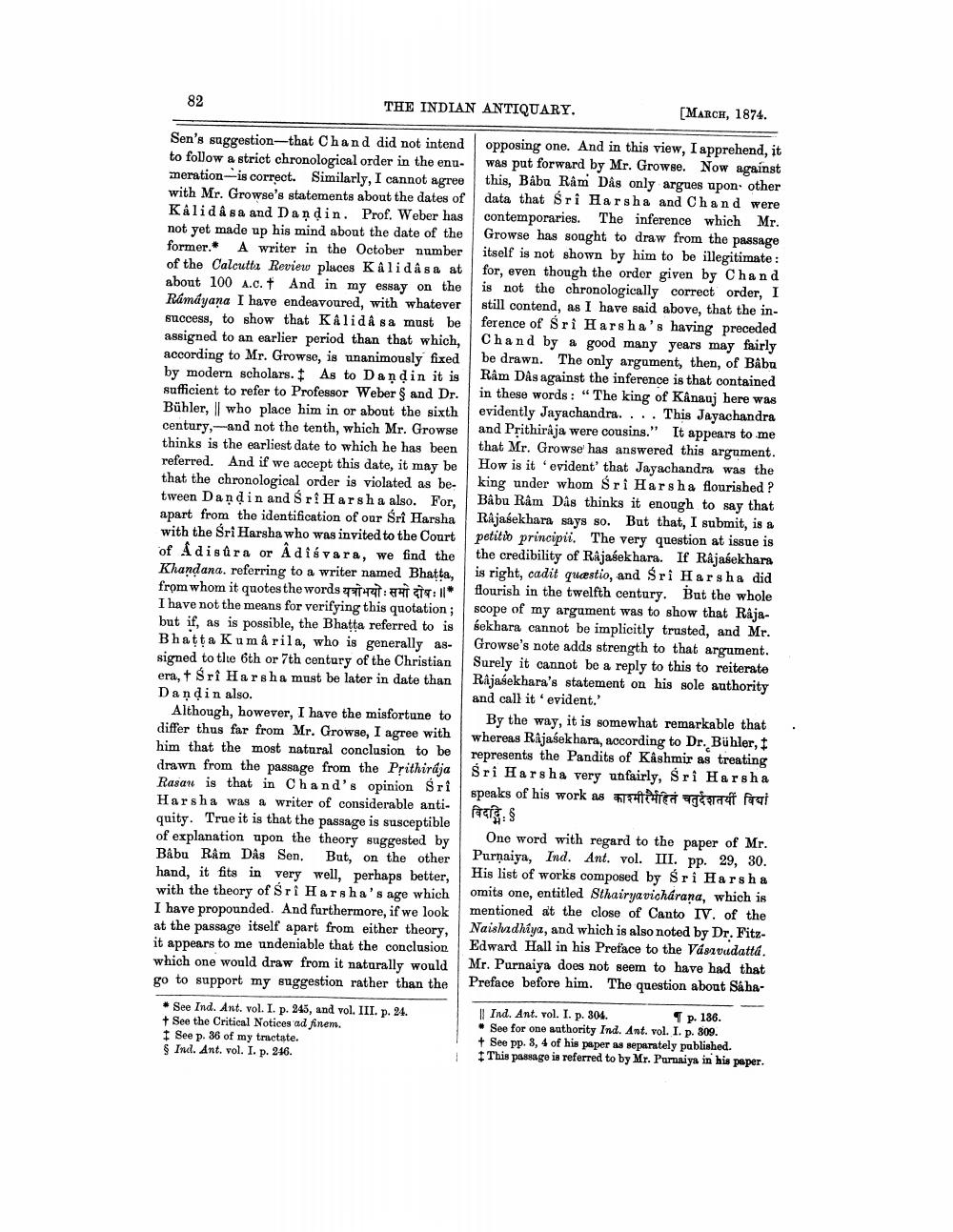________________
82
THE INDIAN ANTIQUARY.
Sen's suggestion-that Chand did not intend to follow a strict chronological order in the enumeration is correct. Similarly, I cannot agree with Mr. Growse's statements about the dates of Kalidasa and Dandin. Prof. Weber has not yet made up his mind about the date of the former. A writer in the October number of the Calcutta Review places Kâlidâsa at about 100 A.c. And in my essay on the Rámáyana I have endeavoured, with whatever success, to show that Kâlidâ sa must be assigned to an earlier period than that which, according to Mr. Growse, is unanimously fixed by modern scholars. As to Danḍin it is sufficient to refer to Professor Weber § and Dr. Bühler, who place him in or about the sixth century, and not the tenth, which Mr. Growse thinks is the earliest date to which he has been referred. And if we accept this date, it may be that the chronological order is violated as between Dandin and Sri Harsha also. For, apart from the identification of our Sri Harsha with the Sri Harsha who was invited to the Court of Adisura or Adiévara, we find the Khandana. referring to a writer named Bhatta, from whom it quotes the words यत्रो भयोः समो दोषः ॥ * I have not the means for verifying this quotation; but if, as is possible, the Bhatta referred to is Bhaṭṭa Kumarila, who is generally assigned to the 6th or 7th century of the Christian era, † Sri Harsha must be later in date than Dandin also.
Although, however, I have the misfortune to differ thus far from Mr. Growse, I agree with him that the most natural conclusion to be drawn from the passage from the Prithiraja Rasan is that in Chand's opinion Śri
Harsha was a writer of considerable antiquity. True it is that the passage is susceptible of explanation upon the theory suggested by Bâbu Râm Dâs Sen, But, on the other hand, it fits in very well, perhaps better, with the theory of Sri Harsha's age which I have propounded. And furthermore, if we look at the passage itself apart from either theory, it appears to me undeniable that the conclusion. which one would draw from it naturally would go to support my suggestion rather than the
See Ind. Ant. vol. I. p. 245, and vol. III. p. 24. + See the Critical Notices ad finem.
See p. 36 of my tractate.
§ Ind. Ant. vol. I. p. 246.
[MARCH, 1874.
opposing one. And in this view, I apprehend, it was put forward by Mr. Growse. Now against this, Bâbu Râm Dâs only argues upon other data that Sri Harsha and Chand were contemporaries. The inference which Mr. Growse has sought to draw from the passage itself is not shown by him to be illegitimate: for, even though the order given by Chand is not the chronologically correct order, I still contend, as I have said above, that the inference of Sri Harsha's having preceded Chand by a good many years may fairly be drawn. The only argument, then, of Bâbu Râm Dâs against the inference is that contained in these words: "The king of Kânauj here was evidently Jayachandra. . . . This Jayachandra and Prithiraja were cousins." It appears to me that Mr. Growse has answered this argument. How is it evident' that Jayachandra was the king under whom Sri Harsha flourished? Bâbu Râm Dâs thinks it enough to say that Rajasekhara says so. But that, I submit, is a petitio principii. The very question at issue is the credibility of Rajasekhara. If Rajasekhara is right, cadit quæstio, and Sri Harsha did flourish in the twelfth century. But the whole scope of my argument was to show that Râjasekhara cannot be implicitly trusted, and Mr. Growse's note adds strength to that argument. Surely it cannot be a reply to this to reiterate Rajasekhara's statement on his sole authority and call it evident."
whereas Rajasekhara, according to Dr. Bühler, t By the way, it is somewhat remarkable that represents the Pandits of Kashmir as treating Sri Harsha very unfairly, Sri Harsha speaks of his work as feet frai
Faraf: S
One word with regard to the paper of Mr. Purnaiya, Ind. Ant. vol. III. pp. 29, 30. His list of works composed by Sri Harsha omits one, entitled Sthairyavicharana, which is mentioned at the close of Canto IV. of the Naishadhiya, and which is also noted by Dr. FitzEdward Hall in his Preface to the Vászvudattá. Mr. Purnaiya does not seem to have had that Preface before him. The question about Saha
Ind. Ant. vol. I. p. 304.
¶p. 136. See for one authority Ind. Ant. vol. I. p. 309. + See pp. 3, 4 of his paper as separately published. This passage is referred to by Mr. Purnaiya in his paper.




